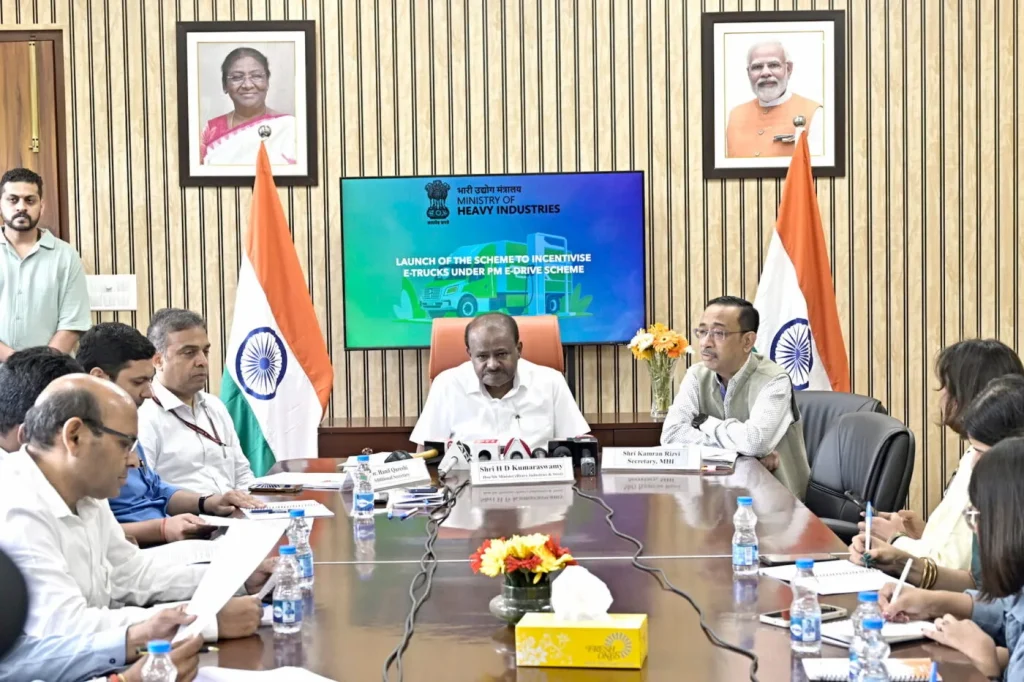India’s Ministry of Heavy Industries (MHI) has released new details on subsidies for electric trucks under the recently launched PM E-Drive scheme. This marks the first time the Indian government is directly supporting the deployment of electric trucks in the country.
Of the total outlay of 109 billion rupees (approx. €1.1 billion) for the PM E-Drive scheme, India’s Ministry of Heavy Industries (MHI) has earmarked five billion rupees (approx. €50 million) to incentivise electric trucks. This accounts for nearly five per cent of the scheme’s budget.
MHI expects this allocation to support subsidies for 5,643 electric trucks in the current financial year (April 2025 – March 2026), including 1,100 units in Delhi, which continues to struggle with severe air pollution.
Under the PM E-Drive scheme, only electric trucks with an ex-factory price of up to 12.5 million rupees qualify for incentives. Depending on the gross vehicle weight (GVW), the subsidy will be the lowest of the following:
5,000 rupees (50 euros) per kWh
10 per cent of the ex-factory price (excluding the cost of trailer)
270,000 rupees (approx. 2,700 euros) to 960,000 rupees (approx. 9,600 euros) as per the table below:
Category
GVW (Tonnes)
Maximum Incentive Per Truck
N2
>3.5 & <=7.5
270,000 rupees (approx. 2,700 euros)
>7.5 & <=12
360,000 rupees (approx. 3,600 euros)
N3
>12 & <=18.5
780,000 rupees (approx. 7,800 euros)
>18.5 & <=35
960,000 rupees (approx. 9,600 euros)
>35 & <=55
930,000 rupees (approx. 9,300 euros)
In line with the government’s ‘Make in India’ initiative, MHI heavily stresses localisation. Effective 1 September, companies interested in making their electric trucks eligible for the subsidy under the PM E-Drive need to ensure they use domestically produced key components like the high-voltage battery pack, DC–DC converter, Vehicle Control Unit (VCU), traction motor, CCS2 charging inlet, HVAC, and the electric compressor for the brake. These requirements slightly vary as per the category, and from 1 March 2026, MHI will mandate even deeper localisation, including the battery management system (BMS).
Along with localisation, MHI emphasises high quality and reliability. It is mandating a minimum warranty of five years/500,000 km on the high-voltage battery pack, five years/250,000 km on the motor, and five years/250,000 km on the electric truck. Moreover, it has stipulated minimum requirements for five key parameters: driving range, energy consumption, speed, acceleration, and gradeability.
range
max. energy consumption
min. top speed
min. acceleration
min. gradability
N2 (3.5t- 12t)
min. 80 km
≤150 kWh/100 km
60 kph
0.8 m/s2
7º
N3 (12t-18.5t or 19.5t with air suspension)
min. 100 km
≤180 kWh/100 km
60 kph
0.5 m/s2
7º
N3 (18.5/ 19.5t- 30t or 31t with air suspension
min. 100 km
≤200 kWh/100 km
60 kph
0.5 m/s2
7º
N3 (30t/ 31t- 46t or 47t with air suspension
min. 100 km
≤275 kWh/100 km
60 kph
0.5 m/s2
7º
N3 (46t/ 47t- 55t
min. 100 km
≤350 kWh/100 km
60 kph
0.5 m/s2
7º
MHI will offer the subsidies as an upfront reduction in the purchase price and issue a reimbursement to OEMs via the PM E-Drive portal. Commenting on the launch of the scheme, H.D. Kumaraswamy, the Minister of Heavy Industries, said, “Diesel trucks, though constituting only 3% of the total vehicle population, contribute to 42% of transport-related greenhouse gas emissions and significantly worsen air pollution.”
Along with the guidelines for availing subsidies, MHI has announced that the government’s largest steel producer, Steel Authority of India Limited (SAIL), will procure 150 electric trucks by 2027 and deploy them across multiple locations. Further showcasing its commitment to EV adoption, SAIL will ensure that EVs account for a minimum of 15% of all the vehicles it hires across its units.
pmedrive.heavyindustries.gov.in (guidelines; PDF), pib.gov.in (press release)

